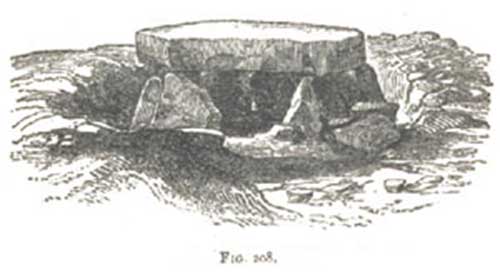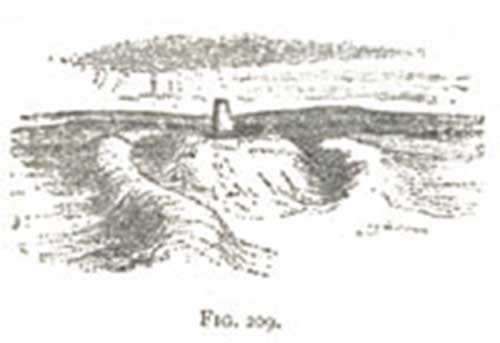Cromlechs and Pillar-stones in Ancient Ireland
From A Smaller Social History of Ancient Ireland 1906
« previous page | contents | start of chapter | next page »
CHAPTER XXVII....continued
A cromlech is formed of one great flat stone lying on the tops of several large standing stones, thus enclosing a rude chamber in which one or more bodies or urns were placed. These cromlechs are very numerous in all parts of Ireland, and various theories were formerly in fashion to account for their origin; of which the most common was that they were "Druids' altars," and used for offering sacrifices. It is now, however, well known that they are tombs, which is proved by the fact that under many of them have been found cinerary urns, calcined bones, and sometimes entire skeletons.
FIG. 208. Phoenix Park Cromlech: found under a duma or burial-mound. Covering stone, 6½ feet long. (From Proceedings Royal Irish Academy).
Sepulchral monuments of the same class are found all over Europe, and even in India Some cromlechs are formed of stones so large that to this day it remains a puzzle how they were heaved up to their places by people devoid of powerful mechanical appliances. The covering stone of the cromlech at Kilternan, on the summit of a hill between Dublin and Bray, which is figured on page 544, and which is one of the largest of its kind in Ireland, is 23 ½ feet long, 17 feet broad, and 6 ½ feet thick. It is lifted so high that a man can stand straight up under its higher end.
Sometimes regularly formed cromlechs—usually small—are found under dumas or mounds; like that shown in fig. 208, which still stands in its original place in the Phoenix Park, Dublin. It was found in the year 1838 under a large earthen tumulus which was cleared away: several urns were dug out of the mound; and under the cromlech lay two human skeletons. But, generally speaking, cromlechs, that is to say, comrars formed of a few massive stones, were erected in the open air, and were not covered up.
Pillar-Stones.—The various purposes for which pillar-stones were erected have been already stated (page 424). Here we have to do only with their sepulchral use. All through the tales we find mention of the head-stone or pillar-stone, called by the names lie or lec and coirthe [curha], placed over a grave. A usual formula to describe the burial of a person is:—His funeral rites were performed, his grave was dug, and his stone erected, with his name inscribed in Ogham. In accordance with these accounts, sepulchral pillar-stones are found all over Ireland, some inscribed with Ogham, some not: the inscription, as already stated, usually telling the name of the person, with the name of his father, and often a few other brief particulars. Perhaps the most remarkable and interesting pillar-stone in all Ireland belonging to pagan times is that erected over the body of King Dathi in the cemetery of Croghan; but it bears no inscription. In later ages the pagan pillar-stone developed into the ordinary headstone with a Christian inscription.
FIG. 209. King Dathi's Pillar-stone. (From Proceedings of the Royal Irish Academy).
Tombs with Christian Inscriptions.—After the establishment of Christianity it became customary to erect a tomb over the grave, having a flat slab on top, especially in the cemeteries of monasteries, with an inscription, generally in Irish, but sometimes in Latin. In many cases the monument was a simple inscribed pillar-stone; so that some of the headstones that are mentioned under the last heading would fall also under this.
A most interesting Christian inscribed pillar-stone, probably the oldest in Ireland, is the headstone of Lugnaed or Lugna [Loona], standing about two and a half feet over ground, near the very ancient little church of Templepatrick on the island of Inchagoill in Lough Corrib, of which Dr. Petrie has given a full account in his "Round Towers." It is figured on next page from his accurate illustration in the same book.


